Abstract
Radial growth and wood density are important traits in assessing wood quality. Our objective was to investigate patterns of variation of radial growth (ring width, earlywood width, latewood width, latewood proportion) and wood density (ring average density, earlywood density, latewood density) components in a 30-year-old Pinus brutia at two test sites in Turkey. Wood increment cores at a height of 1.30 cm (dbh) from 1,010 trees at age 30 years were evaluated at two test sites. The radial growth and wood density traits of the individual rings were measured using X-ray densitometry. The test sites showed statistically significant differences in the radial growth traits but not in the wood density traits, suggesting that the wood density traits are less subject to environmental changes. The ring average density was relatively low (485 kg/m3) at early cambial ages (near the pith) and increased to 501 kg/m3 at later cambial ages (near the bark). The latewood density was 550 kg/m3 near the pith, increased steadily to 630 kg/m3 at cambial age 12, and remained stable thereafter. In contrast, the earlywood density and latewood proportion were highest near the pith. The twelfth ring from the pith appeared to represent the transition from juvenile to mature wood. The unique relationships among early and latewood densities and latewood proportion in the juvenile and mature wood contribute to more uniform wood both within a given annual ring and between the juvenile and mature portions of the stem in P. brutia. Thinning increased the ring width, latewood proportion, and ring average density.






Similar content being viewed by others
References
Adamopoulos S, Milios E, Doganos D, Bistinas I (2009) Ring width, latewood proportion and dry density in stems of Pinus brutia Ten. Eur J Wood Prod 67:471–477
Alteyrac J, Cloutier A, Zhang SY (2006) Characterization of juvenile wood to mature wood transition age in black spruce (Picea mariana (Mill.) BSP) at different stand densities and sampling heights. Wood Sci Technol 40:124–138
Berges L, Nepveu G, Franc A (2008) Effects of ecological factors on radial growth and wood density components of sessile oak (Quearcus petraea Lielbl.) in Northern France. For Ecol Manag 255:567–579
Boydak M (2004) Silvicultural characteristics and natural regeneration of Pinus brutia Ten.—a review. Plant Ecol 171:153–163
Burdon RD, Kibblewhite RP, Walker JCF, Megraw RA, Evans R, Cown DJ (2004) Juvenile versus mature wood: a new concept, orthogonal to corewood versus outer wood with special reference to Pinus radiata and P. taeda. For Sci 50(4):399–415
Decoux V, Varcin E, Leban JM (2004) Relationships between the intra-ring wood density assessed by X-ray densitometry and optical anatomical measurements in conifers: consequences for the cell wall apparent density determination. Ann For Sci 61:251–262
Erkan N (1998) Fast growing species and Pinus brutia. Workshop, Orman Bakanligi Yayin Dairesi Baskanligi no:63, Ankara (in Turkish, English abstract)
Fisher JT, Neuman RW, Mexal JG (1986) Performance of Pinus halepensis/brutia group in southern New Mexico. For Ecol Manag 16:403–410
Guller B (2007) The effects of thinning treatments on density, MOE, MOR and maximum crushing strength of Pinus brutia Ten. wood. Ann For Sci 64:467–475
Guller B (2010) Determining wood density of Turkish red pine (Pinus brutia Ten.) by using X-ray densitometer. SDU For Fac J 2:97–109
Guller B, Yasar S (2010) Estimation of Pinus brutia Ten. wood density from Fourier Transform Infrared (FTIR) spectroscopic bands by Artificial Neural Network (ANN). Sci Res Essays 5:1765–1769
Isik K (1986) Altitudinal variation in Pinus brutia Ten.: seed and seedling characteristics. Silvae Genet 35:58–66
Isik K (1988) Interlocked honeycomb design with three replications and its application on a population genetics analysis of Turkish red pine (Pinus brutia Ten.) (in Turkish, English summary). Turk J Agric For 12:377–386
Isik F, Isik K, Yildirim T, Li B (2002) Annual shoot growth components related to growth of Pinus brutia. Tree Physiol 22:51–58
Jaakkola T, Mäkinen H, Saranpää P (2006) Wood density of Norway spruce: responses to timing and intensity of first commercial thinning and fertilization. For Ecol Manag 237:513–521
Jyske T, Mäkinen H, Saranpää P (2008) Wood density within Norway spruce stems. Silva Fenn 42:439–455
Libby WJ, Cockerham CC (1980) Random non-contiguous plots in interlocking field layouts. Silvae Genet 29:183–190
Lindström H (2002) Intra-tree models of juvenile wood in Norway spruce as an input to simulation software. Silva Fenn 36:521–534
Megraw RA (1985) Wood quality factors in loblolly pine. Tappi Press, Atlanta
Nyakuengama JG, Downes GM, Ng J (2002) Growth and wood density responses to later-age fertilizer application in Pinus radiata. IAWA J 23:431–448
Palmberg C (1975) Geographic variation and early growth in south-eastern semi-arid Australia of Pinus halepensis Mill. and Pinus brutia species complex. Silvae Genet 24:150–160
Raiskila S, Saranpää P, Fagerstedt K, Laakso T, Löija M, Mahlberg R, Paajanen L, Ritschkoff AC (2006) Growth rate and wood properties of Norway spruce cutting clones on different sites. Silva Fenn 40:247–256
Raymond CA, Dickson R, Rowell D, Blakemore P, Clark N, Williams M, Freischmidt G, Joe B (2004) Wood and fiber properties of dry-land conifers. RIRDC Publication No 04/099, p 69
SAS Institute (1990) SAS/STAT User’s Guide. Version 6, 4th edn, SAS, Cary
Savva Y, Koubaa A, Tremblay F, Bergeron Y (2010) Effects of radial growth, tree age, climate, and seed origin on wood density of diverse jack pine populations. Trees 24:53–65
Smith DM (1954) Maximum moisture content method for determining specific gravity of small wood samples. US Forest Service, Forest products Lab. Report No:2014
Tassisa G, Burkhart HE (1997) Juvenile—mature wood demarcation in loblolly pine trees. Wood Fiber Sci 30:119–127
Usta HZ (1991) A study on the yield of Pinus brutia Ten. Plantations. Turkish Forest Research Institute, Technical Bulletin No: 219, Ankara, Turkey, p 138
Weinstein A (1989) Geographic variation and phenology of Pinus halepensis, P. brutia and P. eldarica in Israel. For Ecol Manag 27:99–108
Zobel BJ, Sprague JR (1998) Juvenile wood in forest trees. Springer Series in Wood Science, Springer-Verlag
Zobel BJ, Van Buijtenen JP (1989) Wood Variation—its causes and control. Springer Series in Wood Science, Springer-Verlag, p 363
Acknowledgments
The study was supported by The Scientific and Technological Research Council of Turkey (TUBITAK) under Project No: 106O442 and also by a post-doctoral research grant to Dr. Bilgin Guller at North Carolina State University (NCSU), Raleigh, NC, USA. We thank Dr. Steve McKeand, Dr. Fikret Isik and the staff of the NCSU Tree Improvement Program for their helpful suggestions and for providing X-ray facilities. Yusuf Kurt, Adnan Guller and Asli Gocmen helped during the sampling of the wood cores, and Dr. Brad St. Clair (USDA Forest Service, Corvallis, Oregon) thoroughly revised the language of the manuscript. Dr. Kani Isik established the test sites in 1979 and since then, the staff of the Forest Service and the Southwest Anatolia Forest Research Institute in Antalya has maintained the test sites. The Akdeniz University Scientific Research Fund and Suleyman Demirel University provided partial support and laboratory facilities. Two anonymous reviewers made precious suggestions on an earlier draft of the manuscript. The authors are grateful to all these persons and institutions.
Author information
Authors and Affiliations
Corresponding author
Additional information
Communicated by T. Fourcaud.
Rights and permissions
About this article
Cite this article
Guller, B., Isik, K. & Cetinay, S. Variations in the radial growth and wood density components in relation to cambial age in 30-year-old Pinus brutia Ten. at two test sites. Trees 26, 975–986 (2012). https://doi.org/10.1007/s00468-011-0675-2
Received:
Revised:
Accepted:
Published:
Issue Date:
DOI: https://doi.org/10.1007/s00468-011-0675-2




